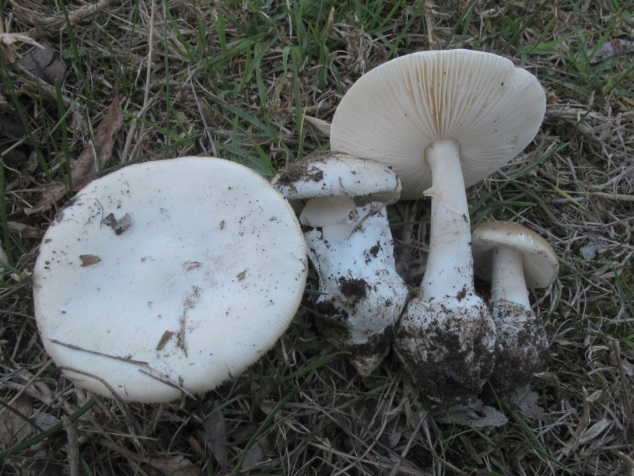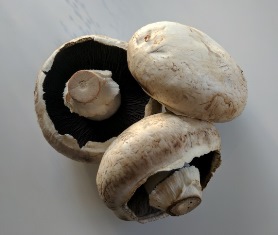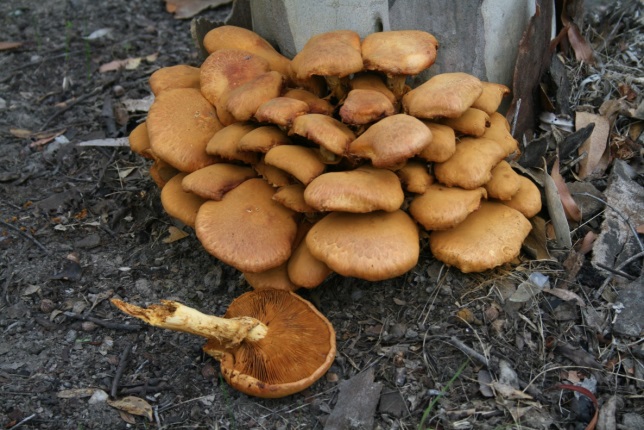Marbled Death Cap mushrooms
- The Marbled Death Cap Mushroom is a type of wild mushroom that is extremely toxic.
- Do not gather or eat wild mushrooms due to the risk of poisoning.
- These mushrooms look similar to some varieties sold in supermarkets, as well as those used in Chinese cooking.
In 2016, the potentially deadly Marbled Death Cap mushroom (Amanita marmorata) was found growing in the Denmark region of south-west Western Australia (WA). These look similar to the edible, non-toxic, field mushroom (Agaricus sp.) that can be purchased from many supermarkets or greengrocers.
What do Marbled Death Cap mushrooms look like?
The Marbled Death Cap is a large mushroom, with a marbled white, greyish or brownish cap and white gills underneath. There is a white ring on the stem and the base of the stem is surrounded by a cup-shaped sac. The poisonous parts found within Marbled Death Cap mushrooms are in the cap, gills, stem and spores.

Image: Marbled Death Cap mushroom (Amanita marmorata) is known to cause poisoning if eaten.
Source: Katrina Syme
|

Image: Field mushrooms (Agaricus campestris) which are available from supermarkets and greengrocers and are safe to eat.
Source: Department of Health, Western Australia
|
Where are Marbled Death Cap and other wild mushrooms found?
Mushrooms are most commonly found in autumn associated with warm, humid weather and often after significant rainfall. They are found growing in:
- parks
- gardens
- nature strips
- farmland
- woodlands and forrests.
Many mushrooms species are associated with trees. The group of mushrooms the Marbled Death Cap mushroom belongs to are found in higher rainfall regions of WA such as the South-west and Great Southern regions. However the distribution of toxic mushrooms within WA is currently not known and so it is best to avoid eating any wild mushrooms.
While commercially produced mushrooms are safe to eat, people who collect wild mushrooms for consumption may inadvertently eat toxic species or specimens that are old and past their prime, leading to poisoning and illness. Cooking, peeling, soaking or drying these types of mushrooms does not remove or inactivate the poisons.
Some toxic mushrooms look very similar to those used in Chinese cooking. As there is no easy way to distinguish between safe and toxic mushrooms without formal identification, it is advised not to collect or consume wild mushrooms.

Image: Wild mushrooms found growing from the base of a tree in the Southwest of Western Australia.
Source: Elaine Davison.
What are the symptoms of toxic wild mushroom poisoning?
Mortality rates from Death Cap mushrooms are around 50 per cent, and in some cases, death can occur within as little as 48 hours but may take longer. There is enough poison within a single mushroom cap to kill an healthy adult.
After initial consumption, gastro-intestinal symptoms normally develop within 6 to 24 hours. Anyone who becomes ill after eating these mushrooms, and has symptoms such as those listed below, should seek urgent medical advice – and if possible – bring samples of the whole mushroom for identification which may be required.
- stomach pains
- nausea
- vomiting
- diarrhoea.
These can progress to:
- liver injury
- bleeding
- kidney damage
- multiple organ failure.
If poisoning is suspected, seek medical attention immediately.
Toxins found in other wild mushrooms cause a wide range of signs and symptoms within a few hours of consumption, but these are usually milder in effect than those caused by Death Cap mushrooms.
There have been multiple incidents and fatalities associated with Death Cap and other wild mushrooms in other parts of Australia.
How can you prevent mushroom poisoning at home?
Most young children who eat poisonous mushrooms find them in the garden at home. Children younger than 5 years of age have a natural inclination to put things in their mouths. Pets may also be affected if they consume toxic mushrooms growing in the garden or local park.
You should regularly check your garden for mushrooms and remove them to reduce the risk of accidental poisoning. When removing mushrooms from the garden, wear disposable gloves and wash your hands thoroughly after placing the mushrooms in the rubbish bin.
Where to get help
- Call the Poisons Information Centre 13 11 26
- If you have severe symptoms, always dial triple zero (000) to call an ambulance in a medical emergency
- See your doctor
- Ring healthdirect on 1800 022 222
This publication is provided for education and information purposes only. It is not a substitute for professional medical care. Information about a therapy, service, product or treatment does not imply endorsement and is not intended to replace advice from your healthcare professional. Readers should note that over time currency and completeness of the information may change. All users should seek advice from a qualified healthcare professional for a diagnosis and answers to their medical questions.